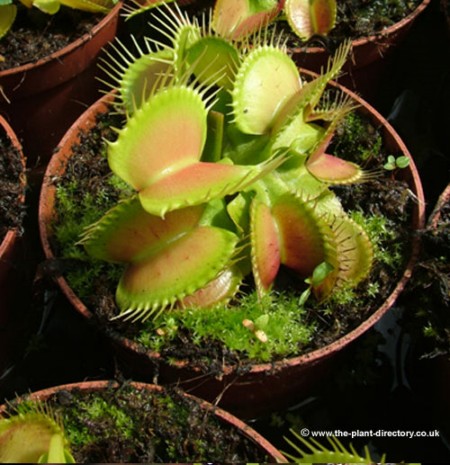Dionaea muscipula
Bladene sitter i en rosett, og bladstilken er vinget. Den er en flerårig urt som er grønn hele året. Bladet er omdannet til en fangstorgan. Det er hengslet så det kan klappe sammen om byttet.
Ten mięsożerny kwiat należy do rodziny roślin rosiczkowatych.

Muchołówka żywi się głównie muchami, robakami i pająkami. Dionaea muscipula, czyli muchołówka amerykańska, pochodzi z Ameryki Północnej. Hodowla muchołówki – uprawa, pielęgnacja – co jeszcze powinieneś wiedzieć? Most forms consist of a small rosette of leaves (called petioles), each of which ends in a trap.
Cultivars are generally selected for colour, size, or mutation. These include Dionaea ‘Justina Davis’, which remains completely green even in full sun, and Dionaea‘Akai Ryu’ (also known as ‘Red Dragon’), which develops a striking maroon or burgundy colouration over the entire plant.
Particularly large varieties include ‘Slack’s Giant’ and ‘South West Giant’, the latter of which originated right here in the UK.

Finally, there are the mutants. These are typically the result of tissue culture mishaps, and some are deformed to the point of being unable to catch. See full list on carnivorousplants.
Venus Flytraps need direct sunlightfor healthy growth. If you’re growing your plant indoors, choose a bright sunny windowsill (preferably south-facing if you’re in the UK).
Insufficient sunlight will cause your flytrap’s leaves to become weak and floppy, and the insides of its traps will lack red colouration. They do not require a terrarium to grow, although they often appreciate the higher humidity of the enclosed environment. They can be happy in terrariums provided you respect their winter dormancy requirements (see below) and provide sufficient light. They can grow extremely well in conservatories and unheated greenhouses.
You need to mimic the conditions of their natural habitat, which means providing a cold resting period. Plants growing in unheated greenhouses can remain there over winter. As the days shorten and the temperature drops, your plant’s leaves will start to turn blackand your plant will die back to the rhizome. This is normal, and you can safely trim off any dead growth.
If you’re looking to buy, sell, or trade seeds, I suggest you read up on the seed bank scheme which is operated by the UK Carnivorous Plant Society. You should avoid fertilisers for similar reasons.
Your best options are rainwater, distilled or deionised water, or water produced by a reverse osmosis system.

I’ve outlined your options in more detail here. They prefer to grow in soil which is wet, but not completely waterlogged. During winter they require less water, and the soil should be kept justdamp.
You can buy bags of suitable peat-based mixes from specialist nurseries and on Amazon. If you keep your plants indoors then you can feed them with dead or live insects, but you should do so only once you’ve taken care of all their other growing requirements. If you’re interested in learning more, I’ve listed some recommended resources and blogs below. In my opinion, this is the single best book on carnivorous plants you can buy today.
The impact of peat ext. Its chapters on Dionaea are brilliantly detailed and great for beginners beginners. Available on Amazon. This website is maintained by Bob Ziemer and sponsored by the ICPS.
If you’re struggling to find a photo of a particular Dionaea variety or cultivar, make this your first port of call. Details Needs genus description – D. Each rosette comprises or more leaves with a flat green stalk ending in a hinged trap to 2cm across. Definition of dionaea muscipula in the Definitions.
Meaning of dionaea muscipula. What does dionaea muscipula mean? Information and translations of dionaea muscipula in the most comprehensive dictionary definitions resource on the web. Dionaea consists of only the Venus flytrap (D. muscipula ), well known for its quick-acting snap trap and commonly sold as a novelty.
Once classified within Droseraceae, the Portuguese sundew ( Drosophyllum lusitanicum ) is now placed within its own family, Drosophyllaceae (order Caryophyllales), of which it is the only species. In the wil plants growing in open locations with the greatest exposure to the sun will develop the most vivid colouration to their traps, while plants that grow in more shaded locations will have less colouration and their leaves may tend to grow in a more upright habit as they search for the light.
La plante carnivore dionée ou attrape-mouche. Histoire, géographie, entretien et photos. Structura capcanelor este formată din porțiunea finală a frunzelor. It has a short stem.
A estrutura de captura é formada por dois lóbulos unidos pela base e presos na ponta de cada uma das folhas.